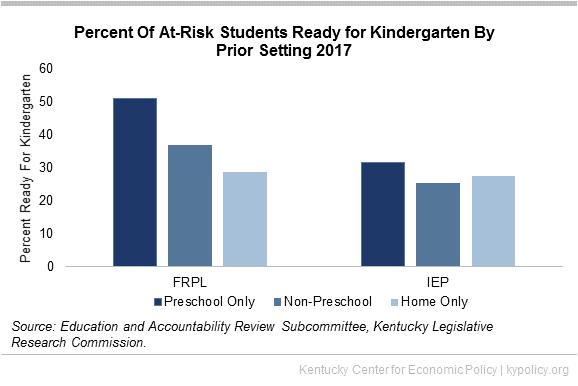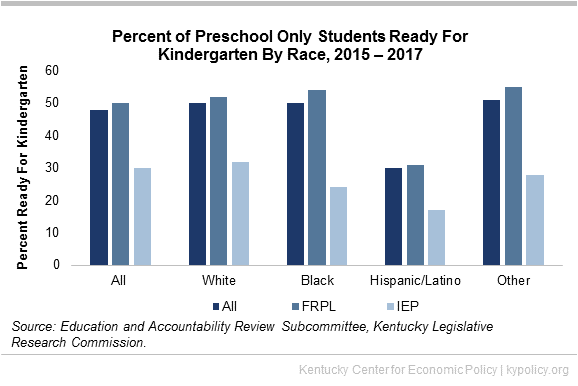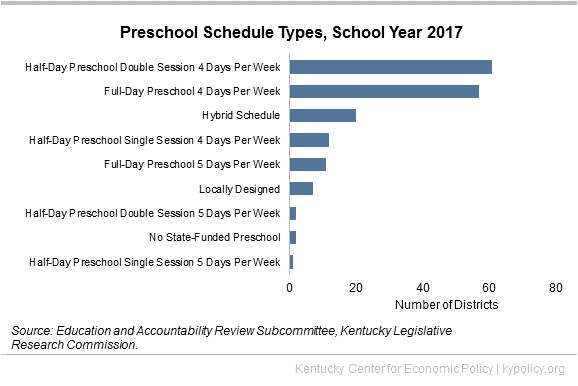High quality early childhood education has long been understood to be an important investment with a significant return. While our state has done more in recent years to expand access to preschool and full-day kindergarten, a new report from the state Legislative Research Commission shows there is real need for additional investments.
Preschool
The report describes how effective our state’s preschool program is at preparing children for kindergarten — especially those from low-income households or who have disabilities. However, while full-day preschool is shown to be most effective just 40 percent of Kentucky school districts offer more than a half-day preschool program, largely due to funding constraints.
Kentucky’s public school districts are required to provide free preschool for three-year-olds and four-year-olds with disabilities and four-year-olds with household incomes up to 160 percent of poverty. For all other four-year-olds interested in enrolling, school districts can enroll students as space permits and may charge tuition, which 61 did in 2017. Tuition rate range from $900 to $5,550 a year, and 4 schools tie tuition rates to parental income. Two districts, Lee County and Wolfe County, do not currently provide preschool services but instead serve preschool students by contracting with their local Head Start providers.
Kentucky Preschool Programs Effective
The new report shows Kentucky’s preschool program is effective at preparing students for kindergarten:
- Free and Reduced Price Lunch (FRPL) preschool students had higher kindergarten readiness rates compared to their non-preschool counterparts by approximately 15 percentage points, and preschool students receiving special education services (Individual Education Plan (IEP) students) had higher rates of kindergarten readiness than non-preschool IEP students by roughly 6 percentage points.
- Kindergarten readiness rates for state-funded preschool students receiving FRPL or special education services are almost twice as high as the readiness rates of FRPL and IEP students that listed only “home” as their prior setting.
- Among FRPL students with a prior setting of preschool alone, a slightly larger share of African American students were ready for kindergarten than white students. This is an important data point as further down the line in school there are significant achievement gaps between these groups. The report recommends the Kentucky Department of Education (KDE) engage in a longitudinal assessment of the relationships between kindergarten readiness and K-PREP, the standardized assessment in Kentucky for grades 3 through 8, and other indicators of future academic success.
However, it is important to note that for Hispanic/Latino students even preschool attendance unfortunately doesn’t mitigate the achievement gap for kindergarten readiness — an important area for further investigation. It is also notable that less than half of all Limited English Proficiency (LEP) students participate in state-funded preschool despite more than 80 percent qualifying for FRPL. The report recommends school districts, with support and guidance from KDE, complete a needs assessment analysis to determine whether the educational needs of preschool-aged LEP students are being met and to explore possible resources to assist in meeting their needs.
Full-Day Preschool Most Effective but Offered at Less Than Half of Districts
Preschool programs in Kentucky can be either half-day (a minimum of 2.5 hours of classroom time each day) or full-day. Half-day preschool can be five days a week or four days with the fifth day used to provide children and families with services such as home visits or special experiences for children. However, another option is for districts to have a locally designed option approved by the commissioner of education.
Preschool has a particularly positive impact on students who attend for more than 16 hours a week. The average rate of kindergarten readiness in districts with more than 16 hours of scheduled preschool time per week is 13 percentage points higher than in districts with less than 12 hours of preschool per week (54.9 percent compared to 41.9 percent). However, just 40 percent are providing full-day preschool 4 or 5 days a week (districts are only required to offer a half-day program four days per week).
At the same time that it would be beneficial to Kentucky kids for more schools to offer full-day preschool, inadequate funding is a serious concern for many districts. According to the report, districts reported spending $4,395 more per child on average than they received from the preschool funds allocated by the General Assembly. The state does not provide funds for preschool student transportation — which costs an average of $1,035 per preschool student — as districts are not required to provide transportation to preschool students. However, all but 13 schools do provide transportation, which includes being required to provide a driver’s assistant for every bus that transports preschool students. Districts that offer full-day preschool have higher transportation costs. The report notes: “Districts must currently cover these transportation expenses with no funding, which either could result in cuts to other services provided to preschool students or the use of general fund dollars that could have otherwise been spent on supports to other K-12 program initiatives.”
For cost reasons, seven districts currently have only a preschool program consisting of two full days (six hours each day). Most of these districts specifically said they would be able to reduce transportation costs and salaries as a result — with 1 district reportedly saving $198,000 per year and the other, which served fewer students, claiming they would save $52,000 a year. The report notes there may be new cost pressures in the near future due to changes in the federal Head Start program that will result in more students instead attending state-funded preschool. New performance standards set by the Federal Department of Health and Human Services require that if a Head Start program operates in a service area with high quality publicly funded full-day preschool, the Head Start program must prioritize serving young children; this means many Head Start programs will have to shift their funding slots from four-year-olds to three-year-old Early Head Start children. In addition, Head Start will not be allowed to offer double sessions. As result, public preschool programs should expect to serve more four-year-old students.
It is also important to note districts that are able to offer daycare to preschoolers have better enrollment. Some school districts have had challenges recruiting preschool students despite increased access due to changes in the income requirements (most recently by increasing eligibility from 150 percent of poverty to 160 percent); overall preschool enrollment has actually declined. Just 41 districts out of 167 that responded to a survey question reported they offer some form of preschool combined with daycare services in at least some of the schools in their district.
Kindergarten
Investments in full-day kindergarten pay off. According to the report, “Students who attend full-day kindergarten were 1.08 times more likely to score proficient or better on the 3rd grade K-PREP reading test and 1.12 times more likely to score proficient or better on the 3rd grade K-PREP math test when controlling for demographic variables.” These findings are statistically significant and consistent with other research on the topic.
However, some districts aren’t able to afford full-day kindergarten as the state only requires and provides funding for half-day, and funding cuts for K-12 education have been putting further pressure on local districts, making it difficult to maintain existing levels of services let alone do more. The report notes Kentucky has the lowest per-student kindergarten funding of all its bordering states.
Although the state requires only half-day kindergarten for three hours a day, nearly all Kentucky school districts offer full-day kindergarten:
- Just six offer half-day kindergarten.
- Four offer both full- and half-day kindergarten.
- Nine have shifted to full-day within the past seven years. The largest expense in doing so was the increase in salaries and benefits.
- Three districts switched back to half-day between 2013 and 2015 for budget reasons.
KDE is requesting an increase of $171 million dollars in the 2018-2020 budget in order to fund full-day kindergarten across the state, according to the report. The cost per-pupil to offer full-day kindergarten ranges from an estimated $844 per pupil to nearly $3,000 per pupil based on a number of district-specific factors, with the greatest costs coming from salaries and benefits. Out of 31 districts that responded to an open-ended survey question asking if the district had any additional comments related to kindergarten, 21 stated kindergarten was underfunded or the state needed to fund full-day kindergarten. The report quotes an eastern Kentucky district with a very large percentage of students receiving FRPL as responding:
“It is expensive to cover the cost of full day Kindergarten because it is only covered at 50 percent. These students need services quickly and they are funded the least. Earlier intervention is key for [kindergarten] students.”
A Western Kentucky district, with a little over half of their students living in poverty, stated:
“The half day of state unfunded kindergarten costs and the 40 percent of unfunded transportation costs seriously and negatively impacts our district. If the district did not have to bear the impact of the unfunded half day and the 40 percent loss of transportation we would be able to provide more mental and behavior[al] support for schools, more Response To Intervention (RTI) interventionists for our struggling students, lower teacher to student ratios, college and career coaches, and other very needed supports for our schools.”
Additional state funding for districts to provide full-day preschool and kindergarten, as well as supports such as child care, is critical to improving education in Kentucky. And we don’t want to go even further backward, by continuing to cut education more.






